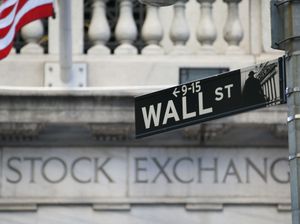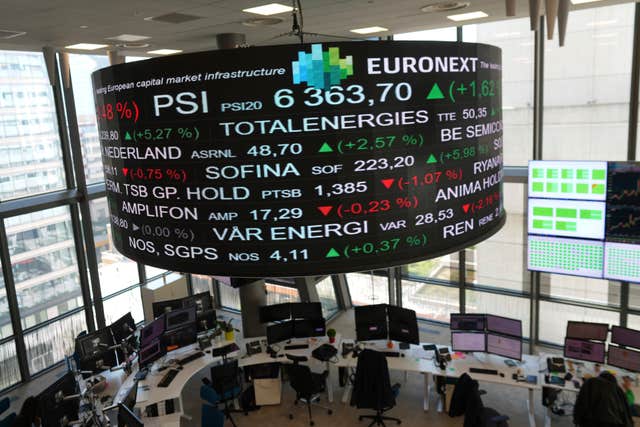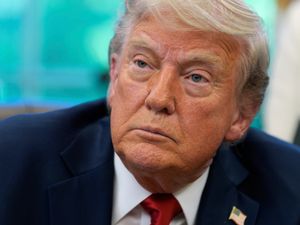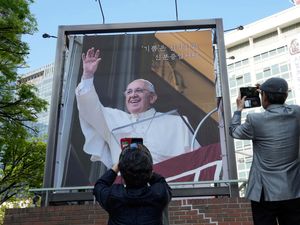Big swings rock Wall Street for second straight day
The markets had been jolted by President Donald Trump’s announcements on tariffs.

Stocks gave up an early rally and briefly went negative as big swings rocked Wall Street for a second straight day.
The S&P 500 erased nearly all of a 4% gain by early afternoon and was up just 0.2%. The Dow Jones Industrial Average was up 254 points, and the Nasdaq composite was near breakeven.
Some relief had flowed through financial markets worldwide earlier on Tuesday as stocks bounced to recover some of their historic losses since US President Donald Trump dramatically raised the stakes in his trade war last week.
The bounce was global. Stock indexes initially rose 6% in Tokyo and 1.6% in Shanghai.
Stock markets throughout Europe notched broad gains amid hopes that the potential for negotiations still exists over the economically damaging tariffs.
Germany’s DAX closed 2.5% after shedding 4.1% on Monday. France’s CAC 40 rose 2.5% after shedding 4.8% on Monday. The UK’s FTSE 100 rose 2.7% after falling 4.4% on Monday.
European markets have been following the same volatile twists and turns as US and Asian markets. They will likely remain volatile amid the uncertainty over how and where the US imposes tariffs, how other nations retaliate and how much damage the global economy sustains.
The price of crude oil also pulled a bit higher after touching its lowest level since 2021 on Monday.

Bitcoin steadied and was back above 79,000 dollars (£61,754) after dropping toward 76,000 dollars the previous day.
No big change is behind the move back upward, and analysts say more swings up and down are likely for markets in not only the days but also the hours ahead.
The big question remains centred on how long Mr Trump will keep his stiff tariffs on other countries, which would raise prices for US shoppers and slow the economy.
If they last a long time, economists and investors expect it to cause a recession. But if Mr Trump lowers them through negotiations relatively quickly, the worst-case scenario can be avoided.
Hope still remains on Wall Street that negotiations may be possible, and Mr Trump said on Monday that he reached the “confines and probability of a great DEAL for both countries” after talking to South Korea’s acting president.
“Their top TEAM is on a plane heading to the US, and things are looking good,” Mr Trump said on social media. “We are likewise dealing with many other countries, all of whom want to make a deal with the United States.”
Japanese stocks led global markets after the country’s prime minister, Shigeru Ishiba, appointed his trade negotiator for talks with the US. It was based on an agreement between Mr Ishiba and Mr Trump, Japanese officials said.
Other countries are taking a more aggressive tack. China said it will “fight to the end” and warned of countermeasures after Mr Trump threatened on Monday to raise his tariffs even further on the world’s second-largest economy.
But such a bounce back for global markets on Tuesday perhaps should not be a surprise. Stocks do not go in one direction forever, and some of the best days in the market’s history have been clustered around some of its worst days.
The biggest gain for the S&P 500 since the Second World War was an 11.6% surge on October 13 2008, for example. That was when worries were high that the financial system was collapsing and the S&P 500 was in the midst of a nearly 57% plunge from its peak in late 2007 until its bottom in March 2009.
A couple weeks later, the index had another one of its best days in history, soaring 10.8%.
That is one of the reasons many financial advisers suggest not trying to time the market and selling stocks and other investments meant for the long term when nervous, because of the risk of missing out on such huge up days.
Some more Republican voices are criticising the White House’s rollout of tariffs, which could sway Mr Trump’s thinking. Senator John Kennedy, a Louisiana Republican, said he supports the president’s goals of better trade deals but worries about the economic uncertainty, for example.
“We don’t know if the medicine will be worse than the disease,” Mr Kennedy said, adding: “This is President Trump’s economy now.”
That follows mixed messages from Mr Trump on Monday. He said he was open to negotiations “if we can make a really fair deal and a good deal for the United States”.
Mr Trump also added that it is possible to have both negotiated settlements with other countries and permanent tariffs.
Mr Trump’s trade war is an attack on the globalisation that has shaped the global economy and helped bring down prices but also caused manufacturing jobs to leave for other countries.
He has said he wants to bring factory jobs back to the United States, a process that could take years.
Mr Trump also says he wants to narrow trade deficits with other countries.
On Wall Street, health insurers helped lead the market after the Centres for Medicare & Medicaid Services announced a stronger-than-expected increase in Medicare Advantage payments for next year. Humana jumped 12.5%, United Health climbed 7.8% and Elevance rose 5.2%.
Levi Strauss rose 2.8% after reporting profit for the latest quarter that topped analysts’ expectations. It also gave a strong forecast for 2025 despite the ongoing trade war and tariff threats.
In the bond market, Treasury yields rallied for a second straight day to recover more of their sharp losses from prior months. The yield on the 10-year Treasury rose to 4.24% from 4.15% late on Monday and from just 4.01% late on Friday.
Yields tend to rise with expectations for the US economy’s strength and for inflation.

Tesla stock market value has lost nearly 400 billion dollars (£312 billion) since the S&P 500 hit a peak on February 19, a stunning 35% plunge. The index, by contrast, has fallen 17%.
Investors pushed Tesla stock to a record high after Mr Trump was elected on hopes Elon Musk’s close ties would help the company. Instead, car buyers angry at Mr Musk’s support for Mr Trump and other right-wing politicians have boycotted his company.
A sharp decline on Monday put Tesla’s stock at 233.29 dollars (£182.36) and below its price on March 19, a key date. That is when Commerce Secretary Howard Lutnick made a surprising endorsement, urging Fox TV viewers to buy the stock in violation of a federal law banning government officials from endorsing companies.
Shares had recovered somewhat in premarket trading on Tuesday.





